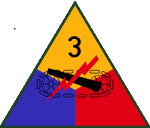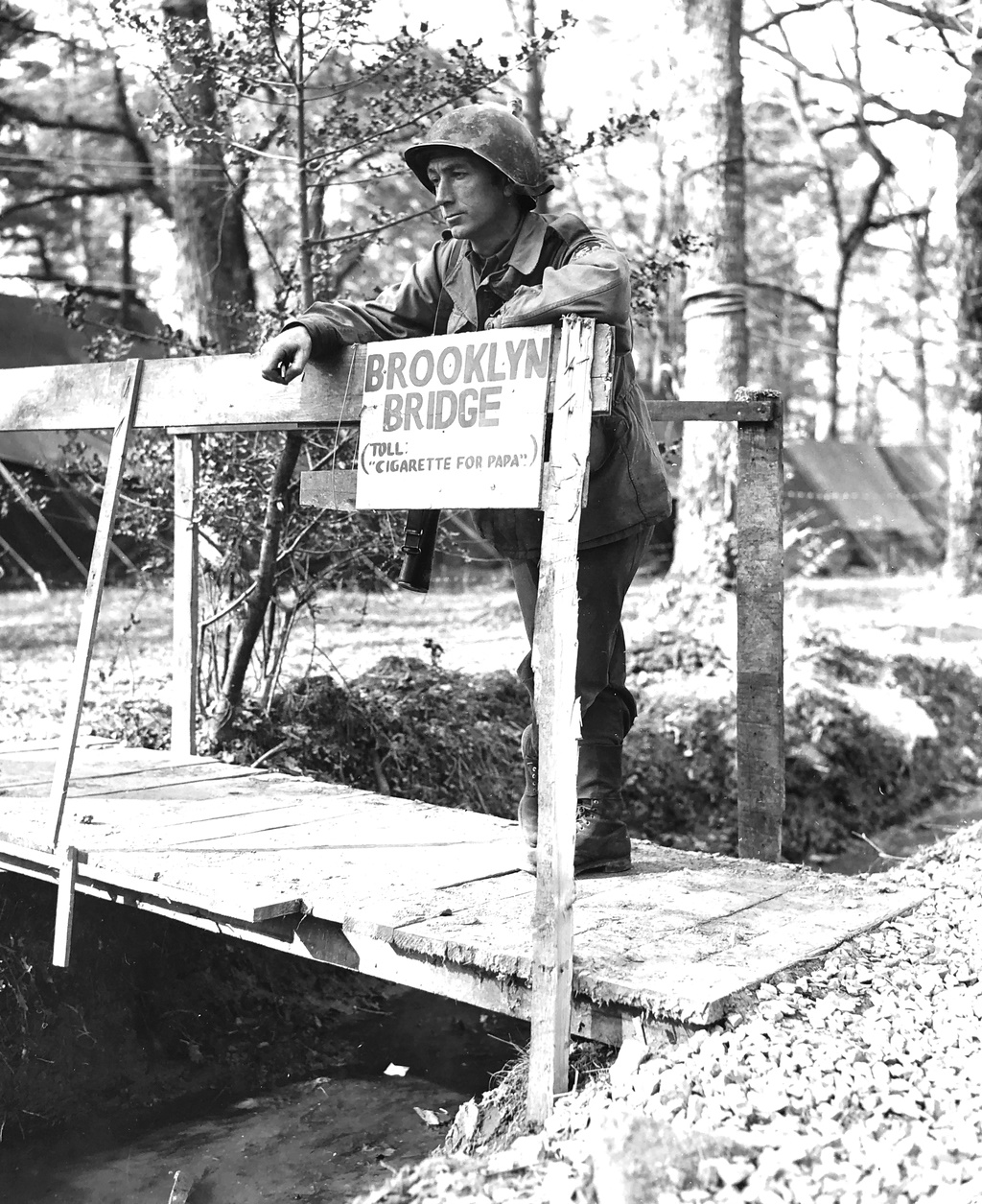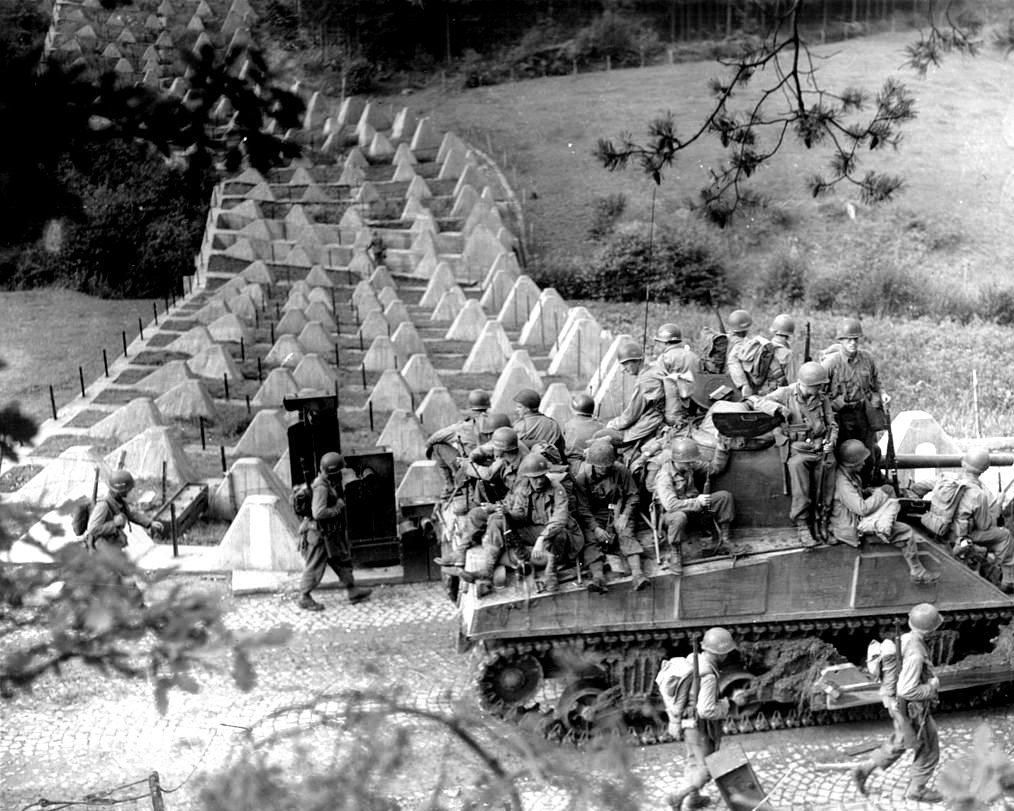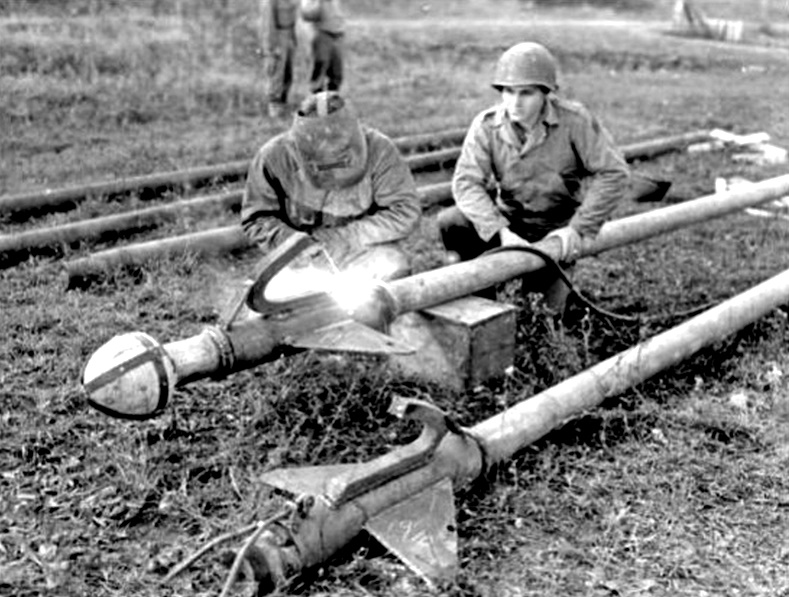Document Source: Operations of the 1st Battalion, 26th Infantry Regiment, 1st Infantry Division during the Initial Penetration of the Siegfried Like in the Vicinity of Nutheim, Germany, September 13 to September 20, 1944, Captain Armand R. Levasseur, Battalion Operations Officer.
INTRODUCTION
This archive covers the operations of the 1st Battalion, 26th Infantry Regiment, 1st United States Infantry Division, during the initial penetration of the Siegfried Line in the vicinity of Nütheim, Germany, September 13-20, 1944. This period began the Rhineland Campaign. To orient the reader, it is necessary to review briefly the events leading up to the arrival of Allied forces on the German Border. In December 1943, at an Allied Conference in Cairo, Gen Dwight D. Eisenhower was selected Supreme Allied Commander for the operation, referred to as Operation Overlord. He was directed to conduct operations aimed at the heart of Europe and the destruction of German forces. The Allied assault was launched on June 6, 1944. American and British seaborne forces, under the command of FM Sir Bernard Montgomery, landed and deployed along fifty miles of the Normandy Coast. This was preceded by heavy naval and air bombardment and an airborne drop of several divisions in vital areas. Resistance from heavily fortified positions along the beaches was bitter and stubborn but by D +1, the ‘crust’ of the German coastal defense system was broken.
Powerful German counterattack forces from the south and east were ordered to wipe out the beachhead. However, Allied Air Force action on bridges, railroads, communication lines, and troop movements was so effective that, the beachhead was secured before successful counterattacks could be launched. Expansion of the beachhead progressed slowly due to ready-made enemy strong points found in the numerous hedgerows coupled with poor observation for artillery employment, rain, and mud. The high quality of the German soldier was also apparent in this fight. By late July, the beachhead was consolidated and four Allied Armies were poised to strike, awaiting only clear weather to permit aerial bombardment. The plan called for an initial breakthrough by the American First Army in the St Lô area through which Gen George S. Patton’s Third Army would strike to unhinge the German left flank for further exploitation. Under clear skies, the attack was launched on July 25, preceded by an air bombardment of 3390 tons concentrated on a narrow front. The breakthrough was complete and by July 28, the Third Army broke out to exploit the success. The battle of Normandy became the battle of France. At this time, Hitler realizing the precarious position of his armies in France, directed the German Seventh Army to stage a large-scale counterattack, using all available armor and motorized infantry with the mission of smashing west to the sea at Avranches, cutting off Gen Patton’s forces.
Due largely to heavy fighter-bomber action by Allied Air Forces, this counterattack was delayed, weakened, and finally called off. The commitment of the German Seventh Army on a counterattack mission that failed delayed the regrouping of this force to the extent that Allied forces trapped and destroyed over 100.000 enemy troops in the Falaise Pocket. Due to the rapid pursuit eastward by the British in the north and the Americans in the south, the enemy*s attempt to establish a line east of the Seine River was committed too late to organize an effective defense. Remnants of the German Seventh Army which escaped through the Falaise Corridor and the German Fifteenth Army now were in full retreat across Northeastern France. As this disorganized force fell back, the Allies pressed the pursuit on the ground and in the air under continued favorable weather. On September 1, 1944, elements of five German divisions were withdrawing to the east near Mons, Belgium, with the sole mission of reaching and manning the Siegfried Line defenses. Simultaneously, First Army units marching along parallel routes immediately to the south, turned north toward Mons, striking the vulnerable extended southern flank of the enemy, pinning him against the British in the north and cutting his retreat to the east. During the following three days, no front line existed. In the resultant confusion, infantry fought in close combat with artillery, and service troops were in at least one instance engaged in street fighting as the enemy attempted to break through our left flank to reach the Siegfried Line. Thousands of the enemy were killed and wounded as they were ambushed along roads; over 20.000 prisoners were captured.
THE SITUATION
The rapid advance from St Lô to the German Border, a distance of 300 straight line miles (657 KM), resulted in critical shortages due to extended supply lines. Local facilities, such as Engelbert Company, a manufacturer of tires – also equipped to recap and repair tires and tubes, were utilized to the maximum to augment available supplies. Units could procure Class III supplies only in reduced quantities as reserves had become exhausted. Some trains returned all the way to the beaches to secure essential gas. The enemy, on the other hand, was utilizing every means to gather his strength for the defense of the Homeland. FM Walter Mödel, in charge of enemy forces in Western Germany, rapidly organized remnants of his western armies into battle groups. These groups, armed with infantry weapons and numerous 88-MM batteries taken from AAA defense of cities, were rushed into the West Wall defenses. In addition, fresh German units from Norway and the Russian front were appearing for the first time in the American First Army sector. The rapid Allied advances of the past six weeks came to an abrupt halt along the entire front during the second week of September 1944.
Future plans of the British in the north called for establishing a bridgehead across the Rhine River north of the Ruhr Basin and the securing of ports at Rotterdam and Amsterdam in Holland. To support this operation the largest airborne operation ever attempted was to take place with a drop behind the enemy lines to secure key bridgeheads. Simultaneously, the American First Army in the south was to strike east to the Rhine between Bonn and Cologne, launching its drive from the vicinity of Aachen, Germany. Its forward elements were searching for weaknesses in the Siegfried Line defenses’ on September 12. The First Army’s VII Corps, on the frontier several miles southeast of Aachen, was facing favorable terrain for tank employment. Also, in the event of penetration, exploitation would be facilitated by good road networks north and east of Aachen. The plan was to envelop Aachen from the south and east, with the 1st Infantry Division on the left wing, the 9th Infantry Division on the right, and the 3rd Armored Division in the center.
A proper appreciation of the task facing the 3rd Armored Division requires an analysis of the Siegfried Line defenses in this sector. The outer perimeter consisted of several rows of pyramidal concrete blocks rising above the ground to form an effective antitank barrier. Where roads crossed the barrier steel gates had been installed or iron rails had been cemented upright into the road. Immediately to the rear of this obstacle, pillboxes were located so as to cover the barrier with fire, thus preventing breaching with demolitions. The depth of the defenses was dependent on the defensive strength of the terrain. Where terrain favored the attacker, the defenses were proportionately greater in depth. In the area a few miles south of Aachen the first belt extended to a depth of 3000 yards (2750 M). Pillboxes were located on the ground providing mutual support and best observation and fields of fire. Distances between pillboxes varied from fifty to several hundred yards. Generally, pillboxes were blind from the rear except when the rear door was open. Firing embrasures permitted only a 50-degree angle of fire. Some contained only one opening whereas others could cover both flanks or contained two mutually supporting guns. Antitank gun emplacements were constructed to accommodate small caliber guns, which had become obsolete against tanks. The standard 88-MM gun had to be dug in outside the position. Inside each pillbox, separate living and sleeping compartments were provided, their number and size depending upon the number of troops for which it was designed
Observation and command posts in forward positions were combined in one installation which in some instances was four stories deep and contained a half dozen or more separate rooms. This type of fortification was entirely underground save for a small cupola to permit observation. Communication between all positions was provided by underground cables. The defense, as a whole, presented a formidable obstacle to an attacking force, over a period of several years since construction, nature had provided the works with a natural camouflage that concealed many positions until after they opened fire. Added to this, some were built to resemble garages, cottages, and other deceptive installations where they would be inconspicuous. The only part of a pillbox appearing above the surface was that essential to meet its tactical requirements plus an overhead cover consisting of several feet of reinforced concrete, which could withstand tank fire at point-blank ranges.
THE BATTALION SITUATION

 On September 3, 1944, the 1st Battalion of the 26th Infantry Regiment was detached from the 1st Infantry Division and attached to the 3rd Armored Division. Its primary employment involved security and mopping up missions behind the fast-moving armored spearheads. For this purpose, it was attached to Combat Command Reserve. Prior to this time, the battalion had been committed in combat continuously since June 6, in Normandy, except for a two-week rest in July. Although it had suffered a large turnover in personnel, morale was high from successive quick victories. Its officers were seasoned, some having participated In four campaigns. The men generally realized that the picnic, wine, and flowers campaign of France and Belgium was at an end. Now, at last, the German was fighting on native soil, so resistance was expected to stiffen. However, the end now seemed within our grasp. Optimism was high, in fact too high in view of the tough battles that lay ahead. Sound tactical doctrine dictated that the enemy’s defenses reached the close of a pursuit which had turned into a route be penetrated as rapidly as possible. The enemy was to be given no breather to recover from the staggerIng blows struck in France and Belgium. For this reason, no time was available for specialized training so valuable to the success of an attack on permanent-type defenses. Also, at the battalion level, little of value was known as to the nature of construction, strength, or depth of the fortifications of the Siegfried Line.
On September 3, 1944, the 1st Battalion of the 26th Infantry Regiment was detached from the 1st Infantry Division and attached to the 3rd Armored Division. Its primary employment involved security and mopping up missions behind the fast-moving armored spearheads. For this purpose, it was attached to Combat Command Reserve. Prior to this time, the battalion had been committed in combat continuously since June 6, in Normandy, except for a two-week rest in July. Although it had suffered a large turnover in personnel, morale was high from successive quick victories. Its officers were seasoned, some having participated In four campaigns. The men generally realized that the picnic, wine, and flowers campaign of France and Belgium was at an end. Now, at last, the German was fighting on native soil, so resistance was expected to stiffen. However, the end now seemed within our grasp. Optimism was high, in fact too high in view of the tough battles that lay ahead. Sound tactical doctrine dictated that the enemy’s defenses reached the close of a pursuit which had turned into a route be penetrated as rapidly as possible. The enemy was to be given no breather to recover from the staggerIng blows struck in France and Belgium. For this reason, no time was available for specialized training so valuable to the success of an attack on permanent-type defenses. Also, at the battalion level, little of value was known as to the nature of construction, strength, or depth of the fortifications of the Siegfried Line.
THE INITIAL PENETRATION
On September 12, strong patrols from CCA and CCB, 3-AD, arrived on the German frontier in the vicinity of Walheim, approximately five miles southeast of Aachen, feeling for possible weaknesses in the defenses. Gen Doyle O. Hickey, commanding CCA-3-AD, formed two groups known as Task Force X and Task Force Y, each composed of a battalion of armored infantry, a battalion of tanks, tank destroyers, and engineers. These task forces assembled in a wooded area several hundred yards southwest of the Siegfried Line‘s outer fringe during the night of September 12/13, preparatory to attack on September 13. The attack was delayed on the morning of the 13 to await bombardment by the Army Air Forces. The Commander of Task Force X, realizing valuable time was being wasted and that results were doubtful, proceeded with the attack, notifying attached air-ground liaison personnel accordingly.
Several attempts to effect a penetration during the day were stopped by heavy small arms fire from pillboxes, heavy mortar, and antitank shelling from positions to the rear. The armored infantry was forced to retire to the woods but the tanks held their ground, firing on the pillboxes at point-blank range. In one instance, 50 rounds of shelling from a tank destroyer on a single enemy strong point failed to neutralize its fire.


























